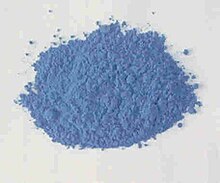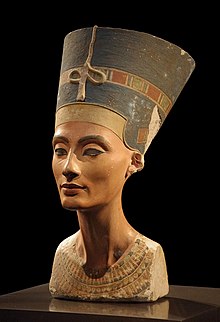Egyptian blue
color code: # 1034A6
Egyptian blue is a blue inorganic mineral pigment that is mostly artificially produced due to its rare natural occurrence. The main coloring mineral phase is cuprorivaite ( ). Modern synonyms Blue frit , frits Blue , Kupferfritte , Pompeijanisch Blue and Copper Blue and Nile Blue in Egypt . Kyanos (Greek) and caeruleum (Latin) are ancient names for the color blue .
features
Egyptian blue is a coarse crystalline pigment (grain size approx. 80 μm ) with a neutral blue, strong color. The “glitter effect” caused by the layered silicate structure is typical . Finely ground varieties (grain sizes smaller than 50 μm) lighten strongly.
In 2013, it was found that the pigment breaks down very easily into extremely thin layers (nanosheets). In addition, when excited by light, these layers would continue to emit strong radiation in the near-infrared range for a long time , which makes the material interesting for applications in biomedical imaging, for light-emitting devices or for security technology.
presentation
A stoichiometric mixture of the metal oxides of its constituents ( silicon , calcium and the coloring copper ) can be used to synthesize Egyptian blue on a laboratory scale . However, it can also be carried out using silicon dioxide and the corresponding carbonates, as Kendrick and Kirk did. For this purpose, the stoichiometric mixtures are z. B. heated in porcelain crucibles to 1000 ° C for 16 hours. The mixture is then slowly cooled, finely ground in a mortar and heated again to 1000 ° C. for 16 hours. Finally, the product is boiled in half-concentrated hydrochloric acid solution to remove unreacted material. Water washed and air dried. The yield can be increased by adding a flux, such as. B. sodium tetraborate, or be increased by pressure.
In the past, to produce finely ground quartz sand and limestone , copper ore or bronze shavings and a little baking soda or salty vegetable ash were added and then burned at at least 870 ° C for several hours. It is important that the ratio of copper to calcium is around 1: 1, because only then does the crystalline layered silicate cuprorivait ( ), the coloring component of the Egyptian blue pigment, arise. Cuprorivaite occurs very rarely in nature. So far it has only been detected in small quantities in Vesuvius lava .
colourfulness
The color of the connection is due to the Cu 2+ cations coordinated in a square planar manner by SiO 4 . With the help of crystal field theory it can be said that the copper cation creates a tetrahedral field, with the oxygen atoms of the silicate being regarded as ligands and treated as negative point charges that interact with the d orbitals of copper. Since the ligands are arranged between the coordinate axes, they mainly interact with the d xy , d xz and d yz orbitals of copper. These neglected orbitals therefore have a higher energy level than the other two d orbitals (d x 2 -y 2 and d z 2 ). The copper brings nine valence electrons into the system and thus occupies both the favored and neglected d orbitals with electrons. With a certain amount of energy, electrons can now be lifted from the favored orbitals into the disadvantaged. This amount of energy is just as large as the energy difference between the d orbitals and is provided by light. The light excites the electrons. These absorb the light that delivers exactly the amount of energy required for the transition. If this light is within the visible spectrum, the complementary color is now visible. With Egyptian blue, yellow light is absorbed and thus blue is visible.
history
Egyptian blue is one of the oldest artificially produced color pigments. Its use in ancient Egypt has been documented by Lucas & Harris since the 4th Dynasty (2639–2504 BC) . The discovery of the pigment was probably closely related to the older production of colored glazed ceramics ( Egyptian faience ), as the same raw materials were used for this.
Egyptian blue was used throughout almost all of the following dynasties. Exceptions can be found in the politically troubled interim times, when mixtures of soot and white were detected as blue pigment . In ancient times , Egyptian blue spread to Mesopotamia , Greece and the Roman Empire and its provinces.
In 2009, with the help of a highly sensitive method, traces of the pigment were detected on some sculptures by the Elgin Marbles . For a long time researchers have suspected that the Parthenon , which now shines in pure white marble, was originally at least partially painted, which can now be seen as certain thanks to this find.
literature
- Heinz Berke: Chemistry in antiquity: the invention of blue and purple color pigments (= Konstanz University Speeches. Volume 222). Universitäts-Verlag Konstanz, Konstanz 2006, ISBN 978-3-87940-802-3 .
- PRS Moorey: Ancient Mesopotamian Materials and Industries. The Archaeological Evidence . Clarendon Press, Oxford / New York 1994, ISBN 978-0-19-814921-7 , pp. 186-189 (English).
- G. Bayer, HG Wiedemann: Egyptian blue, a synthetic color pigment of antiquity, scientifically considered. In: Sandoz Bulletin. 1976, Volume 40, pp. 20-39.
Web links
- seilnacht.com: Egyptian blue
- swisseduc.ch: Egyptian blue
Individual evidence
- ↑ Ancient Egyptian pigment as a new nanomaterial. 5,000 year old dye surprises with nanolayers and a strong near-infrared glow . On: scinexx.de from February 26, 2013; accessed on September 1, 2016.
- ↑ Darrah Johnson-McDaniel, Christopher A. Barrett, Asma Sharafi, Tina T. Salguero: Nanoscience of an Ancient Pigment . In: Journal of the American Chemical Society. Vol. 135, No. 5, 2013, pp. 1677–1679, doi: 10.1021 / ja310587c (English).
- ↑ Gabriele Selvaggio, Alexey Chizhik, Robert Nißler, llyas Kuhlemann, Daniel Meyer, Loan Vuong, Helen Preiß, Niklas Herrmann, Florian A. Mann, Zhiyi Lv, Tabea A. Oswald, Alexander Spreinat, Luise Erpenbeck, Jörg Großhans, Volker Karius, Andreas Janshoff, Juan Pablo Giraldo, Sebastian Kruss: Exfoliated near infrared fluorescent silicate nanosheets for (bio) photonics In: Nature Communications Vol. 11, No. 1495, 2020. doi: 10.1038 / s41467-020-15299-5 (English).
- ↑ E. Kendrick, C. Kirk, S. Dann: Structure and color properties in the Egyptian Blue Family, M 1− x M 'x CuSi 4O 10, as a function of M, M' where M, M '= Ca, Sr and Ba In: Dyes and Pigments January 2007, Vol. 73, No. 1, pp. 13-18 doi: 10.1016 / j.dyepig.2005.10.006 (English).
- ↑ D. Johnson-McDaniel, CA Barrett, A. Sharafi, TT Salguero: Nanoscience of an Ancient Pigment. In: Journal of the American Chemical Society. (J. Am. Chem. Soc.) 2013, Vol. 135, No. 5, pp. 1677-1679, doi: 10.1021 / ja310587c (English).
- ↑ Traces of paint confirmed on Parthenon sculptures. doi: 10.1038 / news.2009.574 (English). On: Nature, online service , June 15, 2009; see also: Parthenon in color. In: www.wissenschaft.de. June 17, 2009, accessed September 9, 2019 .



